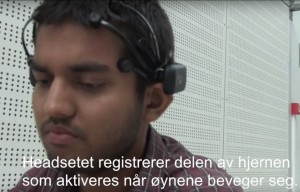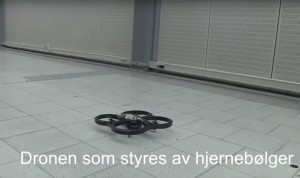Think a thought — and then take flight
It took two students just two months to figure out how to control a drone using brainwaves.
DRONES: A small drone rests on the polished floor in the Elektrobygg at NTNU, looking for all the world like any other drone you’ve ever seen. But it is not.
Sumit Kumar Ram is sitting in front of a laptop near the drone. He wears an EEG headset that reads his brainwaves. Occasionally he blinks his eyes. The PC screen shows all sorts of graphs.
EEG
- Electroencephalography: Method to record electrical activity of the brain along the scalp.
Source: Wikipedia
Geir Kulia stays in the background at first. This isn’t the first time the two students are demonstrating what they’ve accomplished during the two months they have worked together. And it’s no mean feat.
First time in Norway
The pair are controlling the drone with brainwaves, the first time this has ever happened in Norway. Ram is an undergraduate student at the University of Calcutta and has been on an exchange at NTNU.
Ram has selected and adapted the mathematical models and designed the filters. He and Kulia he created the algorithm and software for the project.
Kulia is working on his master’s degree in Electronics at NTNU. He is also a sort of magician who can get the software and mechanics to talk to each other.
At first the drone doesn’t seem to quite be working. It moves up slightly. Turns off. Moves forward a bit.
“It’s swerving slightly to the right, but it’s a mechanical problem, not a problem with the controller,” explains Kulia.
He takes a look at it, makes some slight adjustment or another, and then it no longer swerves.
Detects brainwaves
The drone is controlled with the eyes. Two blinks cause it to lift off. One blink directs the drone either forward or backward.
Ram explains that it isn’t the muscle activity around the eyes that the headset detects, but the parts of the brain that are activated when the eyes move.
He blinks, and then blinks again, twice. The drone is now flying straight down the hall. It’s no longer science fiction, it’s science fact. But it won’t end here.
“We hope that individuals with disabilities will one day be able to use this technology,” says Ram, to control an electric wheelchair, for example, simply by registering brain waves. There is some way to go yet — back and forth aren’t quite enough — but they have begun.
Master’s degrees
This autumn seven Master’s students at NTNU will further develop this technology under the direction of Professor Marta Molinas at the Department of Engineering Cybernetics. It won’t just be used to control a mini helicopter, but also in games. The goal is for different facial expressions to control different functions.
Ram will have returned home to India again by the time this article is published. But he and Kulia hope they can continue to collaborate in the future.





